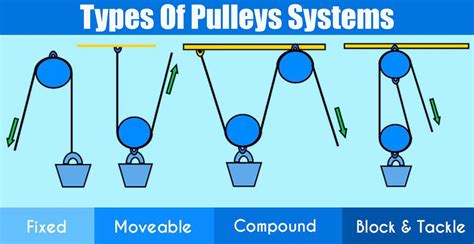The Marvelous Mechanics of Pulleys: A Comprehensive Guide to Lifting with Ease
Introduction
Pulleys are simple yet indispensable mechanical devices that enhance our ability to move objects, both heavy and light. Throughout history, they have played a pivotal role in construction, transportation, and countless other industries, proving their versatility and enduring significance. In this comprehensive guide, we will delve into the world of pulleys, exploring their principles, applications, and effective strategies for maximizing their use.
Understanding the Principles of Pulleys
A pulley consists of a grooved wheel or sheave, mounted on a frame or support, around which a rope or cable is passed. By applying force to one end of the rope, the object attached to the other end is lifted or moved. Pulleys operate on the fundamental principles of force, leverage, and efficiency.
Force Amplification
The primary benefit of pulleys is their ability to amplify force. When the rope is pulled, the force exerted is distributed across the entire length of the rope. As a result, the effort required to lift an object is significantly reduced, allowing even weaker individuals to handle heavy loads.
Leverage
Pulleys create a lever arm by extending the distance over which force is applied. This leverage reduces the amount of effort required to lift an object, making it easier to overcome inertia and move heavy objects.

Efficiency
Pulleys minimize friction and resistance, which enhances their overall efficiency. The use of smooth bearings and low-friction materials ensures that minimal energy is lost during operation, improving the overall efficiency of the lifting process.
Types of Pulleys
Various types of pulleys exist, each tailored to specific applications. The most common types include:
Single Fixed Pulley
A single fixed pulley is mounted on a fixed support, with the rope passing over the sheave. It does not provide any mechanical advantage but changes the direction of the applied force.
Single Movable Pulley
A single movable pulley is attached to the load being lifted, with the rope passing over the sheave. It provides a mechanical advantage of 2, halving the effort required to lift the load.
Compound Pulleys
Compound pulleys consist of a combination of fixed and movable pulleys arranged in a system. These pulleys provide a greater mechanical advantage than single pulleys, significantly reducing the effort required to lift heavy objects.

Applications of Pulleys
Pulleys find widespread applications in diverse industries, including:
Construction
Pulleys are essential for lifting heavy materials, such as beams, panels, and roofing shingles, during construction projects. They simplify the movement of materials, reducing the risk of injury to workers.
Transportation
Pulleys are used in cranes, hoists, and forklifts to lift and move heavy objects in warehouses, factories, and shipping yards. They facilitate efficient loading and unloading of goods, improving productivity.
Manufacturing
Pulleys play a crucial role in assembly lines, conveyor belts, and other manufacturing processes. They help move products through production stages, increasing efficiency and minimizing downtime.
Fitness and Recreation
Pulleys are incorporated into gym equipment, such as weight machines and cable crossovers, to provide resistance during exercises. They target specific muscle groups, promoting overall fitness and strength development.
Effective Strategies for Using Pulleys
Optimizing the use of pulleys requires careful consideration of several factors:
Use the Right Pulley Type
Select the appropriate type of pulley for the specific application. Consider the load to be lifted, the desired mechanical advantage, and the direction of the applied force.
Minimize Friction
Choose pulleys with smooth bearings and low-friction materials to reduce energy loss and improve efficiency. Use lubricants to further minimize friction and extend the lifespan of the pulleys.

Use the Correct Rope
Select a rope or cable with adequate strength and durability for the load being lifted. Avoid using ropes that are too thin or frayed, as they may snap or cause accidents.
Maintain Proper Alignment
Ensure that the pulleys are properly aligned and the rope is routed smoothly. Misalignment can increase friction and reduce the effectiveness of the system.
Tips and Tricks
- Use a pulley with a larger sheave diameter to reduce the force required to lift the load.
- Employ a compound pulley system for heavy loads, significantly reducing the effort required.
- Attach the load to the movable pulley to double the mechanical advantage.
- Use pulleys in combination with other lifting devices, such as levers or hydraulic jacks, to multiply the force amplification.
- Regularly inspect pulleys for wear and tear, and replace worn parts as needed to maintain optimal performance.
How to Use Pulleys: A Step-by-Step Approach
-
Select the appropriate pulley type: Determine the type of pulley based on the load, mechanical advantage, and force direction.
-
Install the pulley: Mount the pulley securely on a support or frame.
-
Thread the rope: Pass the rope or cable around the sheave of the pulley.
-
Attach the load: Connect the load to the appropriate pulley point, such as the hook or the movable pulley.
-
Apply force: Pull the free end of the rope or cable to lift or move the load.
-
Control the load: Gradually release the force to lower the load or adjust its position.
Call to Action
Pulleys are indispensable tools that simplify the process of lifting and moving loads. By understanding their principles, types, and effective strategies, you can harness their power to enhance your productivity and efficiency. Whether you're a contractor, a warehouse worker, or a fitness enthusiast, incorporating pulleys into your workflow can significantly improve your ability to tackle heavy tasks with ease.

